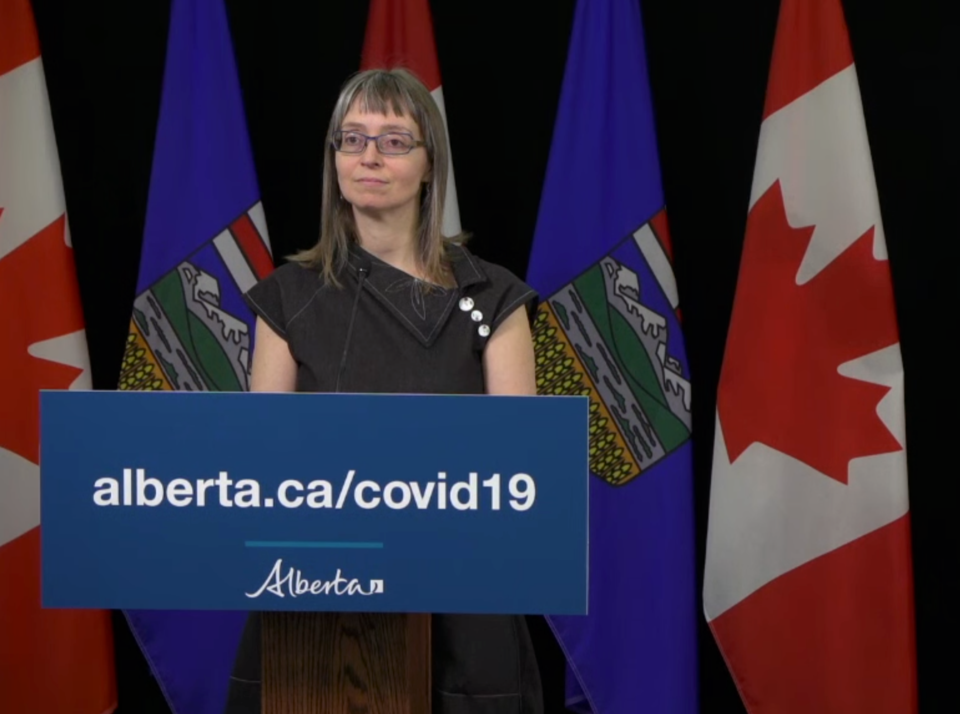ALBERTA – The province is immediately expanding its COVID-19 testing to help control the spread of the virus in Alberta.
Alberta’s Chief Medical Officer of Health Dr. Deena Hinshaw announced Monday (April 13) any Albertans displaying COVID-19 symptoms will now be will eligible for testing.
“We have seen from other jurisdictions that have successfully flattened the curve that aggressive testing is essential to controlling the spread,” Hinshaw said. “Going forward testing all symptomatic Albertans will give us a more complete picture of trending over time.”
Symptoms of the virus include a cough, runny nose, fever, sore throat and shortness of breath.
Hinshaw reported 81 new confirmed cases of COVID-19 bringing the provincial total to 1,732. Of these cases, 254 are suspected to be a result of community transmissions.
There have been two additional deaths in Alberta, bringing the total number of deaths in the province to 46.
A total of 877 Albertans have recovered from the illness.
As of April 13, the Bow Valley still had 17 positive cases. In the Municipal District of Bighorn region, formerly known as the Canmore region, which includes Canmore and some MD hamlets, there were 14 positive cases – four active and 10 recovered. The ID No. 9 region, formerly known as the Banff region, which includes Banff and Lake Louise had three positive cases – all active.
“Preventing the spread prevents deaths,” Hinshaw said. “Another way of preventing the spread of this virus is through testing and putting measures in place for confirmed places and contacts.”
Since the virus first arrived in Alberta the provincial testing lab has expanded its capacity to meet the demands on the health care system, Hinshaw said, adding that in the last 24-hours labs have completed 2,465 tests.
A total of 77,007 people have been tested in the province since the response to COVID-19 began.
Hinshaw said it is important to complete as many tests as possible in a purposeful way based on where the virus is present and with those most vulnerable to COVID-19 to help control the spread in the province.
The current testing capacity of labs is approximately 7,400 tests per day, Hinshaw said. She added that they are hoping to increase these numbers to 9,000 by the end of April and to 20,000 by mid to late May.
Health care workers, those with respiratory illness admitted to hospital, anyone ill in continuing care settings, first responders, correctional facility staff and anyone with COVID-19 symptoms who are 65 years or older, live with someone who is 65 years or older or in the Calgary zone were previously qualified for testing.
It remains critical to stay at home if one is sick and take the Alberta Health Services online assessment form to arrange potential COVID-19 testing.
The province will continue to monitor the volume of completed tests and may adjust eligibility based on lab capacity to perform the tests.
Hinshaw said she is hopeful they will be able to continue to offer this broad access to COVID-19 testing. She added that this will see an increased number of confirmed virus cases in the province but the current rate of infection in those tested is expected to stay at around two per cent.
The province will continue to look at the rate of COVID-19 hospitalizations in Alberta because it provides more accurate data on the spread of the virus in comparison to the total case numbers, she said.
COVID-19 hospitalization trends will be released in the coming days, Hinshaw said, to help Albertans better understand how the virus has spread through the province.
The province has found success in containing the spread of the virus, Hinshaw said, because Albertans have followed the health measures that have been put in place.
Hinshaw said health measures could be in place for many months to come but active discussions have begun on what kinds of actions could be eased when a trend of declining numbers over several weeks takes place. She warned that if the health measures were released too soon it could undo all of the work that has gone into flattening the curve and preventing the spread of COVID-19 in the province.
“These restrictions will not be in place forever,” Hinshaw said. “At this time we are not yet at that point where we can start easing off.”




